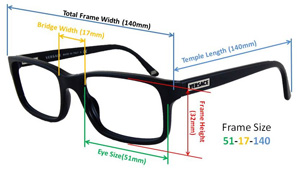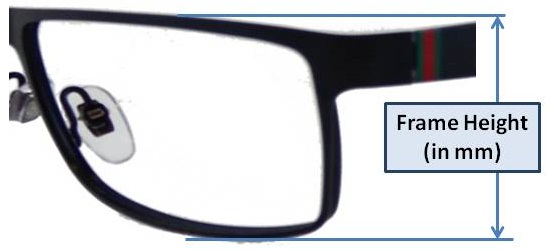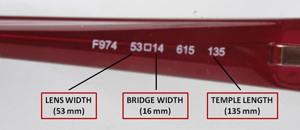You have no items in your shopping cart.
SELECT A RIGHT FRAME
5 Secrects to Help You Select Right Frames
Understand Frame Size:
There are three major parameters provided by frame manufacturer, Eye Size, Bridge Size and Temple Size. You can find these three numbers by looking on the inside of the frame (nose bridge or temple arms).
Following is an example of measurements 53-16-135.
|
|
 |
| Eye Size (Frame Width): | Horizontal measurement in millimeter of lens width. |
| Bridge Size: | Distance in millimeter between two lenses. |
| Frame Height (Lens Height): | Vertical measurement in millimeter of frame. |
| Arm/Temple Length: | Arm length in millimeter from the hinge to the tip. |
| Total Frame Width: | Total frame width in millimeter between two end pieces. |
| (Total Frame Width = Left End pieces + Left Eye Size + Bridge Size + Right Eye Size + Right End piece) | |
Determine Your Frame Size:
The easiest way is to go to eyewear stores and try on different frames to collect following measurements to determine your frame size.
* Eye Size. * Bridge Size. * Temple/ARm Length. * Total Frame Size.
Prescription and Frame Height:
 |
The frame height is measured from the top to the bottom of a frame. |
|
For a single vision eyeglasses, you can select any frames you like. |
|
|
For a bifocal eyeglasses, the minimum frame height is 26mm. |
|
|
For a progressive eyeglasses, the frame height must be at least 28mm. |
Frame Type:
There are three types of frame, full frame, semi-rimless frame and rimless frame.
 |
Full Frame:
|
Full frame eyeglass has a frame that completely encircles the lens. | |
|
Semi-rimless:
|
Semi-rimless frames have the frame either on the top or bottom of the lens. Lenses are mounted to the frame by a thin nylon cord. | ||
 |
Rimless: |
A rimless frame has no frame around the lens. The lenses of a rimless frame are mounted to the frame and nose pad by screws. The lenses used for a rimless frame must be Polycarbonate, high index or Trivex lens material. |
|
Frame Material:
Modern eyeglasses are available in different materials. Each frame material offers its own advantages and style features.
Here is some information of popular frame materials.
| Plastic: | It is easy to mold plastic into modern styles with different color, which makes them popular for modern designers. It is a very cost effective, lightweight and colorful. Most plastic frames are hypoallergenic. |
| Metal: | Metal frames are very popular. They are attractive, durable, cost effective, lightweight, and corrosion-resistant. |
| Stainless Steel: | Stainless steel is an iron-carbon alloy that contains chromium. They are lightweight, strong, flexible, and corrosion-resistant. They are hypoallergenic. |
| Titanium: | It is very lightweight, strong, durable and corrosion resistant. They are 40% lighter than other metals. It is hypoallergenic and an excellent alternative for allergy-prone wearers. |
| Flexon / Memory Metal: | It also known as memory metal, smart metal or smart alloy. With the "memory" factor, it can be twisted or bended to an extreme and return to its original shape. They are hypoallergenic. |




